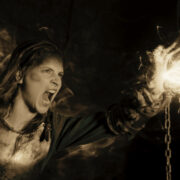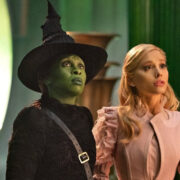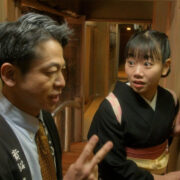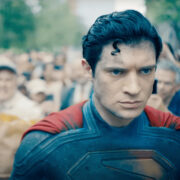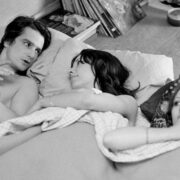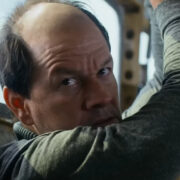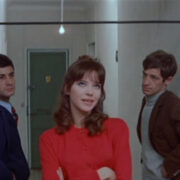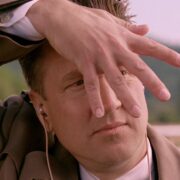The Individual In Edgar Wright’s “Cornetto Trilogy” Part I: Chaos & Conformity In SHAUN OF THE DEAD
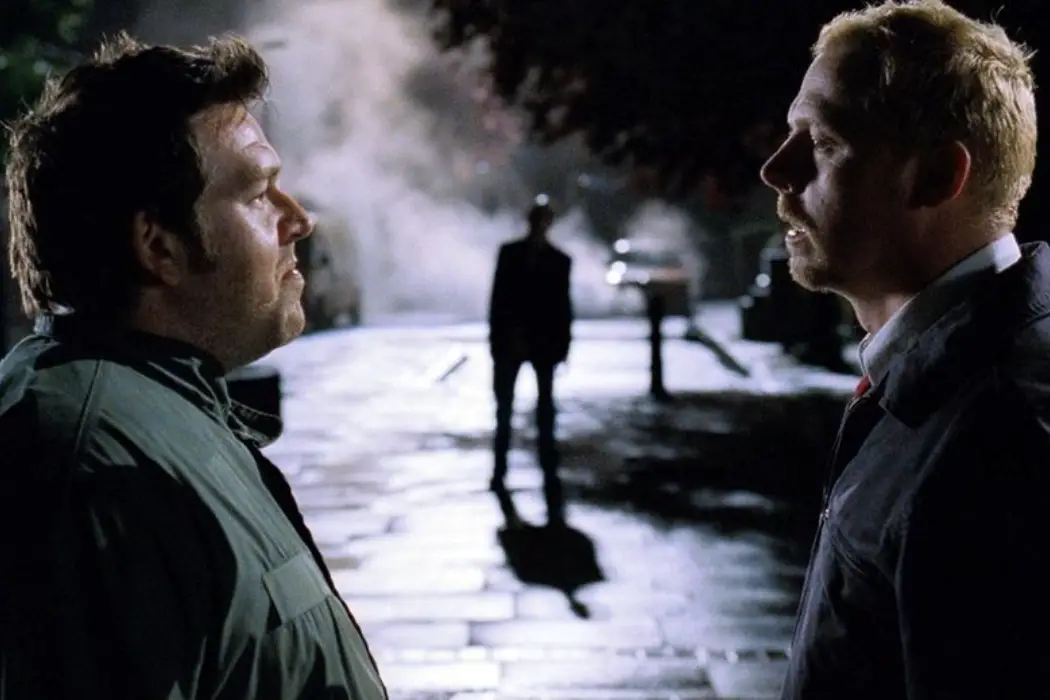
I'm a film journalist and independent filmmaker who fell in…
It’s rather poignant that Simon Pegg should be cast as the protagonist of each of Edgar Wright’s films in the “Three Flavours Cornetto” trilogy (co-written by Pegg & Wright), essentially playing the same man with a different shade. Examining each entry of the trilogy as an alternate reality in a multiverse, Gary King (The World’s End), Nicholas Angel (Hot Fuzz) and Shaun (Shaun of the Dead) are each stuck in a damning vacuum of arrested development, where their state of denial halts their personal growth, and clinging on to a familiar pattern is their philosophy of choice. They are predominantly defined by their relationships with characters played by Nick Frost, who functions not only as Pegg’s “best friend” but also as his moral compass, even while they share an underlying (platonic) romance. The protagonists are eventually challenged by invading entities that dominate and manipulate the local infrastructure, and discover their desires, fears or lack of awareness of their own inhibitions.
Thematically, Shaun of the Dead and The World’s End share a spiritual bond where each has a character with similar desires but arrives at different conclusions. In the case of Hot Fuzz, it both sets up and builds upon character traits from both films (despite the fact that none of them have a story connection), while giving us a strange middle ground that is simultaneously foreboding and reassuring, much like the resolutions of the other films. Even by tackling a different a genre each time (symbolised by a distinct flavour of Cornetto ice cream), one film completes its predecessor like a missing chapter or a puzzle, unlocking a different facet of Pegg’s “character in crisis”.
Especially after the life-changing events transpire, we can see how each narrative paints a vast socio-political landscape, echoing George Orwell and Kurt Vonnegut with prophetic warnings and absurdist commentary, and ultimately defining their respective protagonists and antagonists. It is by examining the various states of chaos and control, through the prisms of anarchy, authority, conformity, anarchy & totalitarianism, and general existential angst, that we can understand the essence and true nature of each of Pegg’s anti-heroes; journeying from an uncertain frame of mind to a bittersweet resolution, while exhibiting the evolution and nuances of their collective soul.
Of course the films are comedies that play with the absurd, but one shouldn’t overlook the dark ideas, satire & themes that ring true with 21st century fears and neuroses, as they did back when Orwell found his cynical hat. With that, the little hand says it’s time to rock ’n’ roll!
Resurrecting Meaty Ideas
For their first entry in the trilogy, Shaun of the Dead, writing duo Pegg and Wright were heavily influenced by George Romero’s “dead” trilogy (1968 – 1985). With sharp satire and a lot of anger, Romero created a merciless apocalyptic world where humanity succumbed to an unknown contagion, spawning countless hordes of zombies, hellbent on consuming and infecting the living. Amidst the biblical chaos, and in the absence of law & order, the dwindling number of survivors had to contend with various factions, gangs and militants vying for control over territories. Just as Romero did when he took jabs at some of contemporary America’s unhealthy obsessions like authoritarianism, consumerism, racism and unnecessary war, Pegg & Wright dressed up a post-9/11 fable with the blood and guts of a dark zombie comedy, enriched by the insightful commentary oozing out of the titular protagonist’s personal arc and his environment.
Shaun The Repressed
Shaun (Pegg) sluggishly lumbers through life without any drive, exciting ambitions or goals; he suffers from a poisonous c*cktail that is the soul-killing mundanity of urban life, while drowning in the deep waters of his own psychological baggage. While he’s fiercely devoted to his mother, Barbara (Penelope Wilton), he doesn’t see much of her because of his long-standing issues with his stepdad, Phillip (Bill Nighy), who’s been tough on Shaun since his teen years. Beyond his dead-end job as an electronics salesman (of which he has little investment and lacks the respect of his colleagues), he does not anticipate any long-term career goals (after a dim-witted employee asks him when he’ll get around to his life goals, Shaun doesn’t know how to respond).
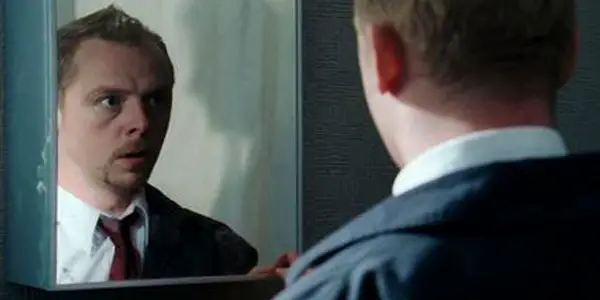
He also can’t seem to fully commit to his girlfriend, Liz (Kate Ashfield), who is fed up with his indecisiveness and lack of adventure, as are her judgmental friends, David (Dylan Moran), and Dianne (Lucy Davis). Instead, Shaun burrows himself into his seemingly eternal (b)romance with his childhood friend and housemate, Ed (Nick Frost), a certified buffoon, drug dealer and slacker who continuously thwarts Shaun’s sense of responsibility, and squanders their time mucking about with Shaun at the Winchester Tavern or playing video games. Shaun’s other housemate, Pete (Peter Serafinowicz), a strict authority figure whose success has spawned much arrogance, harbours a vehement dislike for Ed, whom he considers childish and primitive, pointing to the messy state of the house (which partly encapsulates the deadly clutter that clogs Shaun’s mind).
There are beautifully satirical scenes that highlight the complete self-involvement both Shaun and other Londoners maintain throughout their busy lives. In an early scene, Shaun leaves his house for the shop nearby, looking completely busy and mostly ignoring his surroundings of people in the neighbourhood as he does so. On the morning of the forthcoming invasion, he enacts the same routine, but doesn’t acknowledge the unusual presence of zombies and people running away, nor does he think much of the blood on the floor and fridge in the shop.
Essentially, his emotional and mental state boils down to the love triangle that has cornered him. He likes the idea of being in a serious relationship with Liz, but is constantly steered towards Ed’s allure that promises him a protective bubble that is free from accountability and full of spectacle. The romance isn’t too much of a jump to suggest that if this film was made in the 1980s, then the zombies would serve as a metaphor for the AIDS scare that swept the world, and Shaun would have to make a compromise with his struggling sexuality. If Liz is an establishment of order that can help Shaun mend his unstable situation, then Ed is the seduction of mindless chaos and disorder, who prefers to keep clear blue water between himself and serious adult matters
Chaos Takes Shape
On the eve of the massive zombie outbreak later known as Z-Day (as dubbed by the media), Liz breaks up with Shaun (because he forgets their dinner reservation, on top of everything else) and Pete (after being bitten by zombies whom he mistakes for crackheads) violently berates him for his utter incompetence and for his constant companionship with Ed because it appears to make him feel superior. Shaun is distraught, realising that Ed has always held him back by hiding behind a meaningless facade, and wasted away his existence thus far. This revelatory experience coincides with the following morning’s mayhem, as armies of zombies scatter around London, swamping it with chaos & gore, and inciting mistrust, panic and primal violence amongst the masses. Arguably, this is the perfect canvas to sketch out the complex minefield that is Shaun’s mind, and the more his anxieties and insecurities get the better of him, the more likely others will suffer.
There are strong visual parallels drawn between humanity and zombies, with both entities practically mirroring and mocking each other through the their actions, demeanours and vacant expressions. Early montages and scenes show humans doing things in rhythm and unison; whether it be listening to music or looking at their watches, or pushing a trolley at a supermarket, they always seem lost, mechanical and withdrawn, much like their undead counterparts. In a later scene, Shaun and his friends try to blend in with the zombies surrounding the Winchester, and Shaun’s “impression” is dead-on (pardon the pun), even though it’s not dissimilar to how he behaves when he gets out of bed.

After Shaun and Ed eventually notice the zombies in their garden (as well as Shaun acknowledging the burning chaos within him) and bash their heads in with a bat and shovel (metaphorically shutting down the mechanical nature of otherwise soulless beings), Shaun is left in shock, while Ed casually licks away at his ice cream like nothing strange transpired. While Shaun wants to save his mum and Liz, the news anchor advises viewers to remain indoors, and Shaun takes the message seriously. It is Ed, however (who lives vicariously though his video-games), who persuades Shaun to venture out into the chaos and take action, in a most reckless fashion. Even as Shaun assumes leadership and strategises to keep his family and friends from being infected or killed, it doesn’t take too long for Ed to continually screw things up and create some form of disorder.
The Real Villain
In case it isn’t an obvious clarification, Ed is just as much of a problem as the zombies, and both appear to be a contagion that stem from one particular source. While never explicitly stated, the unseen political power that governs Shaun’s world appears to carry the stench of capitalism, as evidenced by the way crass commercialisation has dominated people’s lives, brainwashing them into conformity and submission. Reminiscent of John Carpenter’s They Live, citizens are kept in a perpetual state of regression and zombified (if you will), whether by burying their faces in their phones or being constantly preoccupied with watching mindless sensationalist entertainment that pops up on the televisions they blindly purchased (a dooming 1980s prophecy that has become a horrifying 21st century reality).
With these citizens already left braindead and dehumanised thanks to the taxingly inflexible routine of working life, they would be far too involved in the vicious circle of their meaningless lives to notice a zombie outbreak. Shaun, for example, notices some of the early signs that involve random deaths, darkly-alarming newscasts, foreboding headlines, people driven to hysteria, and the general presence of zombie activity, but he’s much too entangled in the silky cobwebs of his mind to conclude that these are not ordinary London incidents. In an early scene, Shaun leaves his house to go to a nearby shop before work, looking completely busy and mostly ignoring his surroundings of people in the neighbourhood. On the morning of the forthcoming invasion, he does the same thing, but doesn’t acknowledge the mess and unusual presence of zombies and people running away, nor does he think much of the blood on the floor and fridge in the shop.
While the movie cleverly avoids any direct explanation as to the origin of these monsters, the zombies allude to contemporary horrors of “The War on Terror” era, which involve the unseen enemy, whether they are hiding in plain sight or an external threat. This harkens back to movies like David Cronenberg’s Shivers and Rabid as well as John Carpenter’s The Thing and even They Live, all of which played on Cold War fears of “The Other”; entities who sought to violate us through deception by shape shifting into our image or by simply brainwashing, infecting or transforming us to become one of them. However, due to the ambiguous nature of the cause of the contagion, there is a possibility that it may have come as a result of a government c*ck-up; an internal experiment or job gone wrong, and one that accidentally leaks out the truth about humanity’s existence and place in the world, which the higher powers may wish to suppress.
By keeping its population blissfully ignorant and unquestionably obedient, the higher powers would have much too lose if their citizens started paying attention to the anomalies in their supposedly secure environment, suddenly questioning and rebelling against their authority, thereby descending into anarchy and chaos. The walking dead may not necessarily be the enemy in question, but rather a blessing in disguise, to warn a helpless humanity of the pitfalls of blinding conformity, and to stress the importance of free will and individuality. They are revolutionaries and soothsayers pleading with us to take control of our lives or else we will be consumed by our own self-destruction due to our baseless dependency on social hierarchy which, ultimately, represses our true character.
Waking Up
Ed is a symptom of the government-influenced environment, tainting Shaun’s sense of free will up till the infestation. It is within the state of anarchy, however, that Shaun discovers his own free will and takes his own initiative, shaking off the tight control of both Ed and the government in the process.
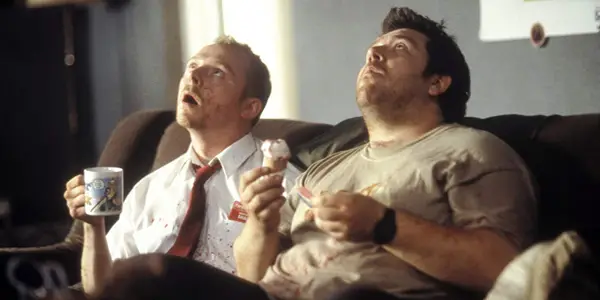
The zombie infections also allow for moments of catharsis and true feelings, as in the case of Pete mouthing off at Ed and Shaun. Before Phillip succumbs to his zombie bite, he becomes the real parent Shaun always wanted, by (with his last words as a human) encouraging him to take charge in the face of difficult tasks and uncertainty. Under advice and pressure from the group, Shaun makes the difficult decision to shoot a zombified Barbara in the head; a selfless act that unlocks his childhood restraints, but also necessary to remove Barbara as a component of the relentless chaos and to end her suffering. When a zombified Pete bites Ed (as the zombies flood the Winchester), Shaun shoots down Pete, revealing his true contempt for bullying authority figures.
A wounded Ed, Liz and Shaun lock themselves in the cellar below the tavern (now set ablaze), contemplating suicide before discovering an exit hatch. Due to the severity of Ed’s wounds, he chooses to stay behind and hold the zombies off, while Shaun leaves with Liz. For once, Ed finally breaks from conforming to the dominating forces of a regressive society, and chooses to be a responsible adult. In an emotional farewell, Shaun rises to the streets with Liz, as Ed is left behind in the fiery tavern of chaos. Outside, as they prepare to fend off the zombies, the military arrives, demolishing the undead in the area, and rescue the couple.
Welcome To The Food Chain
While Z-day has proven to have left an indelible mark on society six months later, nothing has changed for the better. The world still consists of infantilised societies who are more than happy to surrender their intelligence to a higher power, and immerse themselves in unabashed sensationalism, offered to them by the highly influential gods of commerce. Instead of the anarchy of Z-day fulfilling its mission of freeing society from the shackles of hierarchy and purging them of their inhibitions, the consumers remain victims of consumerism and continue to further their abysmal circus of an existence. This time, all the surviving zombies have become the main attraction, with the media making an extravagant feast out of them.
There is no justice or rest for the undead, with society forcefully delegating them to degrading, humiliating roles in various mediums of entertainment and shacking them to performing laborious tasks (pushing trolleys once again), almost indefinitely. The creatures who tried to show the helpless people their true form have been imprisoned by the higher authorities, who will stop at nothing to retain control over chaos, especially through brainwashing their original prisoners (the humans) into loyalty and submission once again. In other words, the zombies have no free will; they are slaves and victims of prejudice, performing for the amusement of blind, weak-minded conformists, who once again offer their child-like obedience to their controlling government.
Both Shaun and Liz seem delightfully content with their lives, but have lost their sense of free will, and end up having fairly uneventful days, that ironically involve them going to the pub.
Before Liz broke up with Shaun, she remarked how she didn’t want to end up being old and sad and wasting away her existence in the pub like those frequent it all the time (Shaun and the like). Just like how the zombies were drawn to the mall in Romero’s Dawn of the Dead as some form of consumerist commentary, the Winchester Tavern (where the climax of the film occurs) is a place in which its customers come to escape the pressures of their aimless existence and their failure to stand up to the oppressive forces that run their lives. It’s a ship in a bottle, completely flooded with denial, regression and self-indulgence, without the possibility of moving forward.
To make matters worse, Shaun found Ed in zombie form, and has him chained inside the garden shed, where Timesplitters 2 is always available for Ed (still retaining that primal instinct) to play and for Shaun to join in when he visits. Shaun hasn’t moved on, and Ed can no longer move on, giving Shaun the best of both worlds by having Liz and Ed living with him. It’s a twisted Utopia, taking place in what was arguably already a dystopia from the get-go, but Shaun seems terribly happy. Perhaps Shaun just wants to be a zombie like Ed, and worse yet, perhaps Liz does.
Shaun’s arc proved that he had the means to prove his self-worth all along, but there is a sense of determinism that a higher power oversee that will ultimately prevent him from having more than just a soupçon of that individuality. Not only does it seem to reference the tight control of totalitarianism in Orwell’s 1984, but it echoes of Kurt Vonnegut’s Breakfast of Champions, where no matter what choices people make, in their quest to discover their place and purpose in the universe, someone (an unreliable narrator) always has other plans for them. Like Vonnegut once wrote, “In nonsense is strength”.
Next up, Hot Fuzz!
Does content like this matter to you?
Become a Member and support film journalism. Unlock access to all of Film Inquiry`s great articles. Join a community of like-minded readers who are passionate about cinema - get access to our private members Network, give back to independent filmmakers, and more.
I'm a film journalist and independent filmmaker who fell in love with cinema at a young age. I also love writing about comics, literature, podcasts, television and video games. I'm just as content watching a movie about a giant killer pig terrorising the Australian outback as I am with one that features a catholic priest in crisis.


